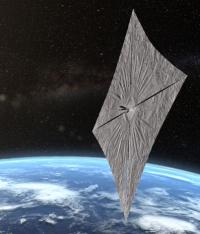 A post not about the sea, but about sailing on the ocean of light from the sun. The idea for solar sailing dates back to 1610, when Johannes Kepler observed that comet tails point away from the sun as if pushed by a celestial wind. In a letter to Galileo, he wrote, “Provide ships or sails adapted to the heavenly breezes, and there will be some who will brave even that void.”
A post not about the sea, but about sailing on the ocean of light from the sun. The idea for solar sailing dates back to 1610, when Johannes Kepler observed that comet tails point away from the sun as if pushed by a celestial wind. In a letter to Galileo, he wrote, “Provide ships or sails adapted to the heavenly breezes, and there will be some who will brave even that void.”
Back in 2014, we posted about The Planetary Society’s Lightsail project, an attempt to launch a solar sail which would be propelled by the momentum of photons of light radiating from the sun. Their first attempt with a prototype was largely successful and since the non-profit society has been raising money and arranging a launch window to send their 32-square-meter solar sail Lightsail 2 into orbit as a light propelled earth satellite. Lightsail 2 is expected to be launched sometime in 2019 aboard a Falcon Heavy rideshare mission called STP-2.
From the Planetary Society website: Once in space, LightSail 2 will attempt to demonstrate solar sailing as a method of propulsion for small, standardized satellites known as CubeSats. The spacecraft will do this by turning its reflective solar sail against the sun’s rays each orbit. Solar photons have no mass, but they have momentum, and will give LightSail 2 a gentle push as they bounce off the sail. The push is no stronger than the weight of a paperclip, but it is continuous and will raise the spacecraft’s orbit by up to several hundred meters each day.

NASS and other science shows talked about these “solar-wind” sails for several years, dont plan on riding on one, you’ll die from radation, lack of Ox, or food before you get very far (space wise).
CUBESAT:
It all started about 17
years ago when California
Polytechnic State
University (Cal Poly) and
Stanford University
developed CubeSat
specifications in order to
promote and develop the
skills necessary for
creating small satellites
intended for LEO
operations.
Until 2013, university
education and research
activities accounted for
the majority of CubeSat
launches. Since then, over
half of CubeSat launches
have been for non-
academic purposes. Today,
most newly deployed
CubeSats are used for
commercial or amateur
projects.
http://www.spacedaily.com/m/reports/History_of_the_CubeSat_999.html
Alas all these plans seem to overlook that the space around earth is highly contaminated with space junk. A recent thought was to have a satellite destroyer to knock out or burnup the debris. NASA and the Indian Space Agency launched an attack satellite. It did work, yet posed greater risk to the International Space Station. It seems they did destroy a larger satellite. The (part I found humurous they didnt think about) destruction instead created over a thousand new particles that are more lethal than the one big one. More interesting use of our tax dollars.
Willy:
Space Junk?
HA!
First China shot/blew-up one of their satellites, then recently this year India did the same!
A NASA Video of space junk on YouTube:
Some as small as paint chips damaged a window on a spacecraft.
https://youtu.be/IOwv1j-fUbo
More:
https://phys.org/news/2018-11-doesnt-tracking-space-junk-wa.html
Satellites are 1000-miles apart to keep signals separated and yet they are 23,500 miles up, the ISS is even higher up.